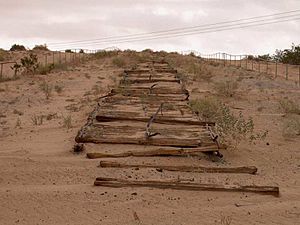Old Plank Road facts for kids
Quick facts for kids Plank Road |
|
|---|---|

Remains of Old Plank Road in 2001
|
|
| Location | Grays Well Road near Winterhaven, California |
| Built | 1915 |
| Reference no. | 845 |
| Lua error in Module:Location_map at line 420: attempt to index field 'wikibase' (a nil value). | |
The Old Plank Road is a special road in Imperial County, California. It was built in 1915. This road helped people cross the Algodones Dunes, which are big sand hills. It connected the southern part of Southern California to Arizona, making it easier to travel between San Diego and Yuma.
Contents
Building the Plank Road
Why a Road Through the Sand?
After Los Angeles became the end point for the transcontinental railroad, leaders in San Diego wanted their city to be important too. They thought a road through the desert would help San Diego become a main hub for travel in Southern California.
The Race Across the Dunes
A businessman named "Colonel" Ed Fletcher was a big supporter of building this road. In October 1912, a newspaper challenged him to a race. The goal was to find the best route between Southern California and Phoenix. A reporter started from Los Angeles, and Fletcher started from San Diego. Fletcher decided to go straight through the shifting sand dunes. He used a team of horses to pull his car through the sand! Amazingly, he won the race in just 19.5 hours.
How the First Road Was Built
After the successful race, Fletcher gathered money from people and local newspapers. They bought 13,000 wooden planks. These planks were shipped from San Diego to Holtville, California.
Workers started laying the first planks on February 14, 1915. Both volunteers and paid workers helped. The road was made of two parallel tracks, each about 25 inches (63.5 cm) wide. These tracks were nailed to wooden pieces laid underneath. The Old Plank Road was 6.5 miles (10.4 km) long. The work finished almost two months later, on April 4.
Keeping the Road Open
Even though the road was a success, it was hard to keep it in good shape. Traffic and sand took a toll on the wooden planks. Crews used mule-drawn scrapers to clear the sand. In June 1915, the California State Highway Commission took over the road. It became part of the main road system connecting Southern California with Arizona.
The Second Plank Road
In 1916, a new and improved Plank Road was built. This one used pre-made wooden sections. Each section was 8 feet (2.4 m) wide. It also had wider spots every 1000 feet (305 m) so cars could pass each other. These sections were brought to the work site by horse-drawn wagons from Ogilby. Then, a crane carefully lowered them into place.
For the next ten years, workers fought against the desert elements to keep the Plank Road open. But it was expensive and difficult to maintain. Also, the ride was very bumpy, and the road was only wide enough for one car at a time. This meant the Plank Road's time was limited.
The Road Today
On August 12, 1926, a new, wider road replaced the Old Plank Road. This new road was 20 feet (6 meters) wide and had an asphalt surface. This same road later became U.S. Route 80, which was then replaced by Interstate 8.
Today, only small pieces of the Plank Road remain. They are protected by the Bureau of Land Management. These pieces are both a California Historical Landmark and can be added to the National Register of Historic Places. You can see parts of the Plank Road at the west end of Grays Well Road, which is a road south of I-8. There's also a monument and a display about the Plank Road about three miles (5.4 km) west of the Sand Hills interchange. The monument even has a 1500-foot (457-meter) long copy of the road, made from old pieces in the 1970s.
California Historical Landmark
The Old Plank Road is recognized as California Historical Landmark number 845. This means it's an important historical site in California. The landmark sign says:
- NO. 845 PLANK ROAD - This unique plank road, seven miles long, was the only means early motorists had of crossing the treacherous Imperial sand dunes. The 8-by-12-foot sections were moved with a team of horses whenever the shifting sands covered portions of the road. Double sections were placed at intervals to permit vehicles to pass
Images for kids



